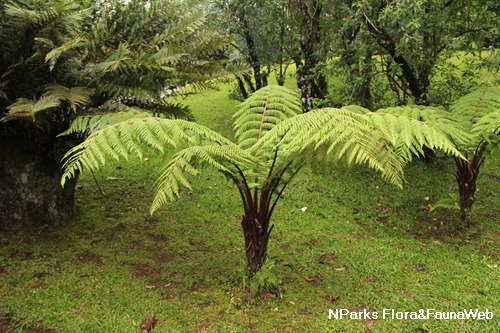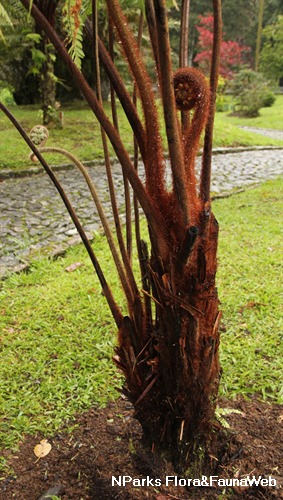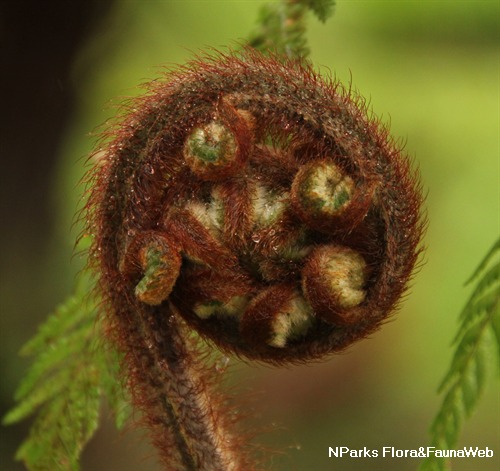
Name
Classifications and Characteristics
| Plant Division | Ferns & Lycophytes (Non-Seed Vascular Plants) (Fern) |
|---|---|
| Plant Growth Form | Herbaceous Plant |
| Lifespan (in Singapore) | Perennial |
| Mode of Nutrition | Autotrophic |
Biogeography
| Native Distribution | Malaysia, Indonesia, Philippines and Papua New Guinea |
|---|---|
| Native Habitat | Terrestrial |
| Preferred Climate Zone | Sub-Tropical / Monsoonal, Temperate |
| Local Conservation Status | Non-native |
Description and Ethnobotany
| Growth Form | Tree fern, able to grow up to about 5 - 6 m tall. |
|---|---|
| Trunk | Base of fern covered with dense, reddish-brown shining hairs measuring about 30 - 500 mm long, upper part of stipe and main rachis covered with sparse pale hairs. |
| Foliage | Lamina measuring up to about 2 - 3 m long, pinnae measuring up to about 70 cm long, pinnules measuring about 15 - 20 mm, frond arrangement usually bi- or tri-pinnate. |
| Habitat | Usually found on mountain ridges, montane rain and cloud forests, between 1500 and 2500 m above sea level. |
| Etymology | Genus Dicksonia honours James Dickson (1738 - 1822), a Scottish botanist. Species blumei named after Karl Ludwig von Blume (1796 - 1862), a German-Dutch botanist. |
Landscaping Features
| Desirable Plant Features | Ornamental Foliage |
|---|---|
| Landscape Uses | Parks & Gardens |
Fauna, Pollination and Dispersal
| Seed or Spore Dispersal | Abiotic |
|---|
Plant Care and Propagation
| Light Preference | Semi-Shade |
|---|---|
| Water Preference | Moderate Water |
| Rootzone Tolerance | Moist Soils, Fertile Loamy Soils |
| Propagation Method | Spore, Division |
Foliar
| Foliage Retention | Evergreen |
|---|---|
| Mature Foliage Colour(s) | Green |
Image Repository
Others
| Master ID | 32156 |
|---|---|
| Species ID | 6562 |
| Flora Disclaimer | The information in this website has been compiled from reliable sources, such as reference works on medicinal plants. It is not a substitute for medical advice or treatment and NParks does not purport to provide any medical advice. Readers should always consult his/her physician before using or consuming a plant for medicinal purposes. |



